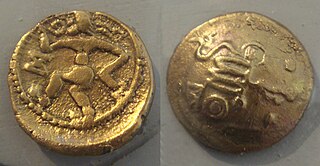Related Research Articles

Cisalpine Gaul was the part of Italy inhabited by Celts (Gauls) during the 4th and 3rd centuries BC.

The Ligures were an ancient people after whom Liguria, a region of present-day north-western Italy, is named.

The Umbri were an Italic people of ancient Italy. A region called Umbria still exists and is now occupied by Italian speakers. It is somewhat smaller than the ancient Umbria.

The Golasecca culture was a Late Bronze Age/Early Iron Age culture in northern Italy, whose type-site was excavated at Golasecca in the province of Varese, Lombardy, where, in the area of Monsorino at the beginning of the 19th century, Abbot Giovanni Battista Giani made the first findings of about fifty graves with pottery and metal objects.
The Medulli were a Gallic tribe dwelling in the upper valley of Maurienne, around present-day Modane (Savoie), during the Iron Age and Roman period.
The Nantuates or Nantuatae were a Gallic tribe dwelling around present-day Massongex, in the modern Canton of Valais (Switzerland) and adjacent areas of France, during the Iron Age and the Roman period.

The Bituriges Vivisci were a Gallic tribe dwelling near modern-day Bordeaux during the Roman period. They had a homonym tribe, the Bituriges Cubi in the Berry region, which could indicate a common origin, although there is no direct of evidence of this.

The Namnetes were a Gallic tribe dwelling near the modern city of Nantes during the Iron Age and the Roman period.

The Vindelici were a Gallic people dwelling around present-day Augsburg (Bavaria) during the Iron Age and the Roman period.

The Nitiobroges were a Gallic tribe dwelling on the middle Garonne river, around their chief town Aginnon, during Iron Age and the Roman period.
The Acitavones were a small Gallic tribe dwelling in the Alps during the Iron Age.
The Adanates or Edenates were a small Gallic tribe dwelling around present-day Seyne, in the Alpes Cottiae, during the Iron Age.
The Aneuniates were a small Gallic tribe dwelling near Lake Como, around present-day Samolaco, during the Roman period.
The Ausuciates were a small Gallic tribe dwelling around present-day Ossuccio, on the western shore of Lake Como, during the Roman period.
The Ecdinii or Ecdini were a Gallic tribe dwelling in the valley of the Tinée (Alpes-Maritimes) during the Iron Age.
The Ambisontes were a Gallic tribe dwelling in the upper Salzach valley during the Roman period.
The Vennones or Vennonetes were a Gallic or Rhaetian tribe dwelling in the northern Alps, between Chur and Lake Constance, during the Iron Age and the Roman era.
The Brigianii were a Gallic tribe dwelling around present-day Briançon during the Iron Age and the Roman period.
The Brixentes or Brixenetes were a Celtic tribe living in the Alps during the Iron Age and the Roman era.
References
- 1 2 3 Vietti 2008.
- ↑ Delamarre 2003, p. 243.
- ↑ C. Cantù, Storia di Como e sua provincia, Como, 1859.
- ↑ Talbert 2000, Map 19 Raetia; Map 39: Mediolanum.
- ↑ M. Gianoncelli, "Vecchie e nuove ipotesi sulla stirpe degli Orobi", in Oblatio; A. Noseda ed, Como, 1971.
- ↑ R. de Marinis, "La civiltà di Golasecca", in La Lombardia, Jaka book, 1985.
- ↑ Pliny the Elder, Naturalis Historia, III, 124-125.
Bibliography
- Delamarre, Xavier (2003). Dictionnaire de la langue gauloise: Une approche linguistique du vieux-celtique continental. Errance. ISBN 9782877723695.
- Talbert, Richard J. A. (2000). Barrington Atlas of the Greek and Roman World. Princeton University Press. ISBN 978-0691031699.
- Vietti, Gianluca (2008). "Orobi". Historisches Lexikon der Schweiz . 047242/2008-10-17.
{{cite journal}}: External link in|postscript=
